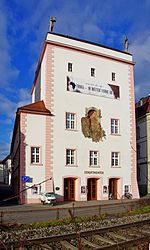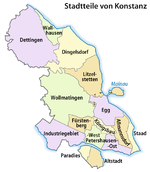Seerhein

The Seerhein (lit. 'Lake Rhine') is a river about four kilometres long, in the basin of Lake Constance. It is the outflow of the Upper Lake Constance and the main tributary of the Lower Lake Constance. The water level of the lower lake is about 30 cm below the level of the Upper Lake. It is considered part of the Rhine, which flows into Lake Constance as the Alpine Rhine and flows out of the Lake as the High Rhine. The Seerhein arose after the last ice age (the Würm glaciation, about 9650 BCE). Some time after this period, the water level of Lake Constance gradually dropped by about ten metres and the shallow parts fell dry. Some parts of the Seerhein still have a character a bit like a lake. The border between Germany and Switzerland runs down the center of the lower stretch of the river; the German city of Constance, the largest community on the river, is situated on both sides of the upper part.
Excerpt from the Wikipedia article Seerhein (License: CC BY-SA 3.0, Authors, Images).Seerhein
Am Rheinufer, Verwaltungsgemeinschaft Konstanz
Geographical coordinates (GPS) Address Nearby Places Show on map
Geographical coordinates (GPS)
| Latitude | Longitude |
|---|---|
| N 47.67 ° | E 9.17 ° |
Address
Am Rheinufer
78467 Verwaltungsgemeinschaft Konstanz, Konstanz-Petershausen-West
Baden-Württemberg, Germany
Open on Google Maps









